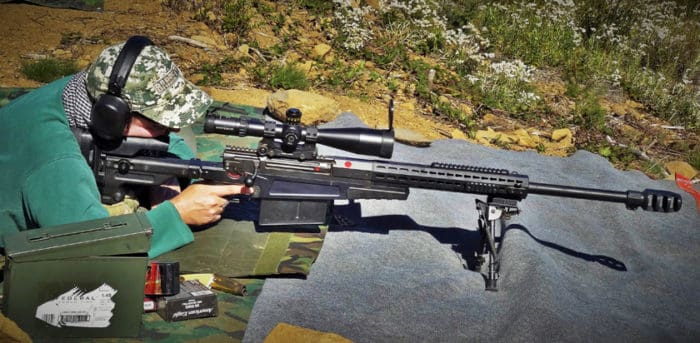A few beginner lessons learned
I’ve been shooting guns for roughly 38 years and have owned many guns, but I’d never owned a rifle chambered in .50 BMG. Still, I’ve had plenty of opportunities to shoot other people’s .50’s, though it was always mere “familiarization” fire, as opposed to spending hours becoming an expert with the weapon system. So the quality time I got while reviewing the Accuracy International AX-50 was something of a new experience, I learned a few things that might be beneficial for anyone thinking of jumping on the .50 cal train.
As a beginner in the fifty field, I quickly discovered that sending 1/2-inch diameter, 750 grain bullets down range offers a unique set of challenges. First off, many gun clubs won’t let you shoot .50 BMG on their ranges, so finding a place to let your .50 stretch her legs can be tough. Even if you find a range willing to let you pull her trigger, you aren’t going to want to shoot this thing at 100 or 200 yards, either.
The massive recoil takes you off the scope longer than say, a .308 or even a .300 Win Mag. As a result, it’s harder to see bullet impact at short ranges. At 1000 yards, I could always see my own .50 BMG round impact steel. If the bullet hit rocks or dirt, I could usually see the dust that got kicked up. At 600 yards, things were a little more iffy: I really had to make sure I was set up perfectly on the gun to ensure I could see my hits. At 100-200 yards…fuggedaboudit.
So the bottom line: if you want to maximize you .50 BMG fun, make sure you have at least 600 yards and preferably 1000 yards. Or, if you can manage it, a mile is even better.
Also you have to put some thought into your targets. Shooting paper isn’t really rewarding at long distances, because you don’t get instant feedback. It’s hard to see what you hit. At 600 yards, ½”-diameter holes were visible on Shoot-N-See targets in good light, especially through my Leica Televid 77 20x-60x spotting scope. But once our targets were in the shade of the late afternoon sun, it got more difficult to see, especially if the shooter missed the Shoot-N-See and hit cardboard. Add a bit of mirage into the equation and the targets quickly get obscured. No fun at all.
To get instant feedback, we mostly shot at my 18-inch diameter, ½-inch thick AR 500 gong from Grizzly Targets, as shown in the photo below. You can see a five-shot group grouping at roughly six inches at 600 yards with Hornady 750 Grain Match (4 of the 5 shots are high-center in a three-inch circle and the 5th flyer on the right opened up the group a bit (Note: the smaller hits are from earlier .223 and .308 impacts).
This target worked well, but we quickly found on an earlier trip that the only thing that would withstand the shrapnel was steel chain. The nylon and cotton webbing that worked so well with conventional rifle rounds were quickly cut by the lead and copper splatter from the big fifty. That was a wasted range trip. The .50 BMG would also bend steel carabiners, as shown above.
Another thing that you need to think about when shooting a fifty is that you need a top-of-the-line optic. Unfortunately, “affordable” options will get destroyed by the recoil. Accuracy International uses and recommends the Schmidt + Bender PM II 5-25×56 and so that’s what we used for our testing. You’ll also need to have scope rings and/or mounts with at least 20-30 MOA of cant built in, because the big fifty requires a lot of elevation adjustment to reach out to distances of up to a mile.
Sighting in the .50 BMG can also be a bit problematic. As I mentioned, you can’t see your own bullet impacts at close ranges, and the large muzzle brake makes it difficult for spotters, too. I found that the only really good location for a spotter was 10 feet directly behind the shooter. Any closer (or if the spotter was off to the side) and the concussion and dust from the muzzle brake would make the spotter flinch.
On one shooting trip last summer, it took me 30 rounds to get the rifle sited in at 600 yards (remember, that’s at about $2.50 per round, at best). In large part, this was because we picked a spot that had a lot of tall grass. The grass made it impossible to see our bullet impacts – we knew we were missing the target, but we couldn’t easily tell if we were hitting high or low. I had never had similar problems with more “normal” sized rifles. Sending an expensive bullet downrange without getting any feedback was very frustrating. So avoid my noob mistake and really plan out where you are going to sight in your rifle.
Shooting a .50 cal rifle – particularly one as finely crafted as the AX-50 – is all kinds of fun. If you get the chance, I can’t recommend it enough. Keep some of these lessons I learned the hard way in mind, and you’ll get the most for your shooting dollar and your time.
